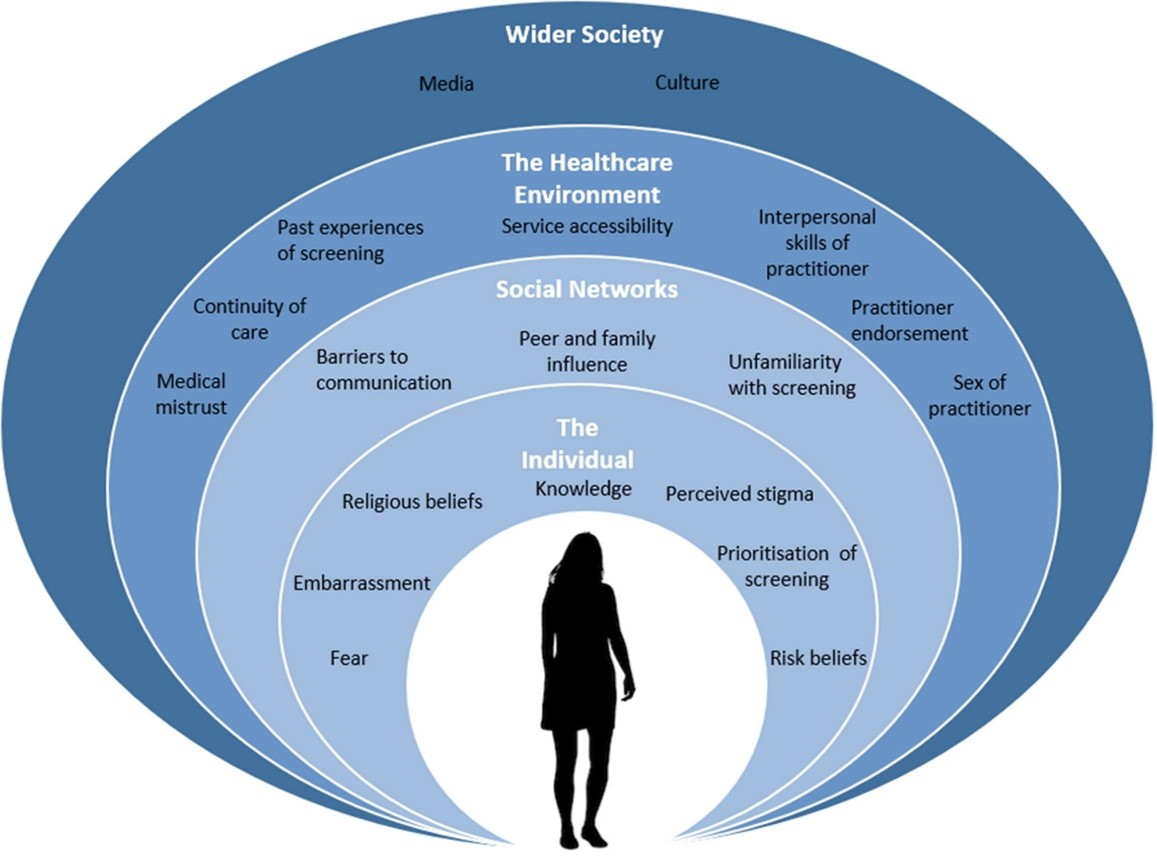Factors influencing cervical screening uptake in underserved women


Factors influencing cervical screening uptake in underserved women
Quick-read summary
Routine cervical screening uptake rates are often lower within deprived communities and/or ethnic minority groups. These groups can therefore be described as being ‘underserved’ in comparison to the general population.
We wanted to gain a deeper understanding of this issue, from the perspectives of those who are least likely to attend. To do this, we collected, reviewed and summarised previously published evidence that described important factors influencing uptake, in underserved women’s own words (for example, evidence from patient interviews or group discussions).
Who is this evidence useful for?
Primary care practitioners, policy makers and/or anyone with an interest in the social determinants of health, women’s health or cancer screening.
What is the issue?
Population wide, routine cervical screening has been shown to significantly reduce cervical cancer rates and cervical cancer-related deaths.
However, there are persistent inequalities in uptake; those living in disadvantaged areas, and those within ethnic minority groups, are less likely to attend in line with guidance.
These inequalities in uptake have also been linked to greater ill-health burden. For example, in England, cervical cancer rates are around 65% higher among those living in the most disadvantaged areas, in comparison to more wealthy communities.
It is important to understand factors that influence attendance within these groups to make sure that people can make informed choices and access screening if they want to.
Past research has often focused on reviewing influential factors broadly, across the general population. This means we do not fully understand how people’s social context, or background, can influence their cervical screening uptake.
There is also very little evidence summarising the most important factors for those who are least likely to attend.
Research summary
We carried out a ‘systematic literature review’ – which means we carefully searched a number of databases and reference lists, to find research articles of interest.
Relevant articles were those that explored factors influencing the uptake of free, routine cervical screening within 1) women living in disadvantaged areas and/or 2) those within ethnic minority communities.
It was important for us to collect evidence that reported key factors in women’s own words (known as ‘qualitative’ research).
We read through relevant papers, noting topics and themes that appeared throughout.
We also considered these themes in the context of individual’s lives and grouped them by ‘level’ – that is, whether the influencing factor was about the individual (e.g. personal thoughts or feelings), their social group, their healthcare provider and so on.
What the research found
Factors influencing cervical screening

The complex relationships between determinants suggest that barriers have a cumulative effect on screening participation. We highlight that this ‘build-up’ of barriers reduces underserved women’s ability to access screening services, and therefore worsens inequalities in participation.
Why is this important?
In comparison to more affluent or privileged groups, underserved women face increased structural barriers to accessing screening services. They also face additional challenges navigating healthcare systems and services, which are not always suitable for those with complex needs.
Our review highlights the need to consider cervical screening participation in the wider context of participants’ lives.
Interventions should be tailored and address barriers at multiple levels, particularly related to the healthcare environment. This is vital to ensure interventions do not unintentionally increase inequalities for those least likely to attend.
How were community groups/patients involved in this work?
The lead author is a lived experience researcher and conducted this research as part of a wider project with input from an ethnically diverse group of women living and working in areas of high deprivation across the North East.
Recommendations and next steps
Policy makers and healthcare providers can play a prominent role in ensuring underserved women feel safe, supported, able to make informed choices and participate in routine cervical screening (if they wish to). This may include:
We observed that there was often an over-emphasis on individual-level factors (which can be unhelpful or even stigmatising for those facing increased structural barriers). We suggest more acknowledgment of individual’s social, economic and environmental context is needed when looking to understand differences in cancer screening behaviours.
Additional work has been carried out to explore these determinants in more detail with women living in areas of high deprivation. This will be written up separately. Work to co-design tailored intervention strategies within this area is ongoing.
Get in touch about this research
Lead researcher name: Dr Angela Wearn
Email address: [email protected]
Twitter/X: @AngWearn